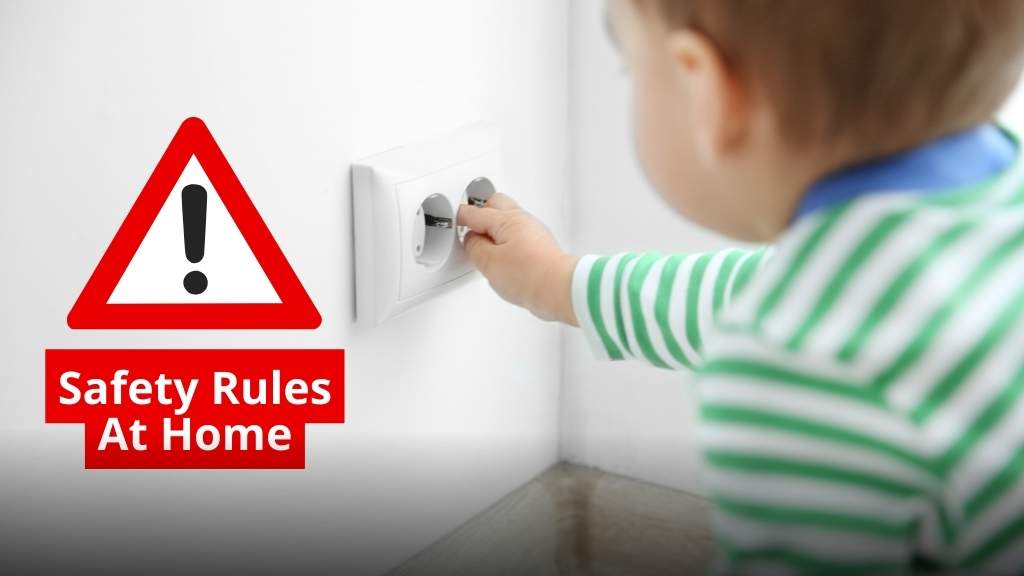
Safety Rules at Home For Kids: Backed by Studies and Research
Needless to say, ensuring safety at home for kids is a top priority for parents and caregivers. At first glance, home may seem like the safest place your kid could be but does that mean there is nothing to be worried about? While common sense plays a vital role, it is essential to base safety measures on research and studies. By relying on evidence-based practices, we can create a secure environment that minimizes the risks children face.
In this article, we will explore rules and measures of safety at home for kids supported by studies and research, providing a solid foundation for safeguarding kids at home. Controlling your kids by restricting their movements around the house is not included because exploration is a developmental gesture for the little human. We need to make sure their curiosity does them no harm.
Here Are The Top 10 Safety Rules At Home For Kids!
1. Supervision
Numerous studies highlight the importance of adult supervision for children’s safety. According to a study conducted by the Centers for Disease Control and Prevention (CDC), supervision significantly reduces the risk of injuries among children.
Constant monitoring and attentive supervision help prevent accidents and enable timely intervention when necessary. Especially, never leave your kid alone in the bathroom because they can drown even in a few inches of water.
2. Childproofing
Research shows that childproofing the home can greatly reduce the occurrence of injuries. A study published in Pediatrics found that implementing safety rules at home, such as using safety gates and cabinet locks, resulted in a significant decrease in child injuries within the home. Proper childproofing creates a physical barrier between children and potential hazards.
3. Fire Safety
Research consistently emphasizes the need for fire safety education. A study published in the Journal of Burn Care & Research demonstrated whoever received education on fire safety at home for kids was more likely to demonstrate appropriate responses during fire-related emergencies. Fire safety practices, including installing smoke detectors and teaching children evacuation procedures, significantly enhance their ability to protect themselves.
4. Kitchen Safety
The kitchen can be a hazardous area for children. A study published in the Journal of Pediatric Nursing found that implementing safety measures, such as keeping children away from hot surfaces and sharp objects, reduces the risk of kitchen-related injuries. Childproofing cabinets and using stove guards were also effective strategies for maintaining safety rules at home.
5. Electrical Safety
Research supports the importance of electrical safety education for children. A study published in the Journal of Pediatric Nursing highlighted that teaching children about electrical hazards and safe practices significantly increased their knowledge and awareness. Implementing measures such as outlet covers and cord organizers further reduced the risks associated with electricity.
6. Bathroom Safety
Studies emphasize the need for bathroom safety measures, particularly for young children. A study published in the Journal of Pediatric Nursing found that using nonslip mats and installing safety locks on cabinets reduced the occurrence of injuries in the bathroom.
Ensuring constant supervision and teaching children to be cautious around water sources were also essential elements of bathroom safety. Follow these tips for bathroom safety rules at home or wherever you go:
- Always keep bathing essentials under your arm’s reach so that you don’t have to leave your kid alone even for a minute.
- If you are using a bathtub for your child’s bathing time, use non-slip strips to prevent accidental falls.
- Test the water temperature by dipping your elbow or wrist in it.
- Unplug and store all your electrical appliances and medicines in a cabinet with a safety lock away from your kid’s reach.
7. Water Safety
According to a study published in Pediatrics, implementing water measures for safety at home for kids can significantly reduce the risk of drowning among children. The study emphasized the importance of installing pool fences and teaching children to swim as preventive measures. Close supervision near bodies of water and enforcing strict rules regarding swimming alone were found to be critical in preventing accidents.
8. Stranger Danger
Research supports teaching children about stranger danger. A study published in the Journal of Abnormal Psychology revealed that children who received stranger danger education were more likely to demonstrate appropriate responses and avoid potentially dangerous situations. Educating children about recognizing and responding to stranger-related risks is crucial for their safety.
9. First Aid Awareness
Studies emphasize the value of first aid education for children. Research published in the Journal of Safety Research demonstrated that teaching children basic first aid skills increases their confidence in handling emergencies and improves their ability to provide assistance. Empowering children with first aid knowledge can make a significant difference in injury outcomes.
10. Emergency Preparedness
Preparing children for emergencies has been proven effective in studies. A study published in Disaster Medicine and Public Health Preparedness emphasized the importance of creating a family emergency plan, conducting regular drills, and discussing evacuation routes. By being well-prepared, children develop a sense of security and confidence in responding to emergencies.
A Final Word on Safety Rules At Home For Kids
Despite the implementation of various precautions and preventive measures, accidents can occur unexpectedly. In such circumstances, it is crucial to be ready and equipped to respond effectively. Acquire knowledge about CPR basics to assist your child in resuming breathing in case of choking or loss of consciousness.
Ensure you have a readily available first-aid kit that includes essential items such as bandages, ointments, burn treatments, antivenom, and any other necessary supplies. Additionally, include contact details of a local physician or medical professional in the first-aid kit to facilitate quick access in case of emergencies.
Essential Safety Rules at Home For Kids FAQs:
1. What is home safety for kids?
Educate children on distinguishing between safe and unsafe situations. By implementing various preventive measures, such as creating safe environments, one can effectively reduce the occurrence of common home injuries such as falls, burns, scalds, poisoning, drowning, strangulation, and suffocation. Moreover, possessing knowledge of basic first aid and CPR is essential for handling emergencies effectively.
2.
What are the basic safety rules for kids?
Here are the basic safety rules at home every child should know:
3.
Why is safety at home?
Ensuring safety at home is crucial for individuals of all age groups. For young children, there is a potential risk of injuries such as unintentional poisoning, falls from elevated places, drowning, or scalds and burns. On the other hand, older adults are particularly vulnerable to falls due to age-related factors like diminished eyesight or mobility.
4.
Why is safety important at home?
By maintaining a hazard-free environment and ensuring the presence of home safety devices, you can effectively prevent minor mishaps like slips and safeguard yourself and your family from critical situations such as fires. Cultivating positive habits within your household contributes to the overall safety and well-being of everyone involved.
5.
How can I make a safe home?
Here are easy safety rules at home you should know:
6. Which of these is a safety rule while at home?
The following are some rules to make your child’s environment safe:
7. Are smoke detectors a good investment?
Indeed, purchasing high-quality safety equipment for children at home is a worthwhile investment that ensures ongoing safety measures at home. Additionally, it is crucial to educate children on the proper usage of fire extinguishers as part of their safety guidelines, empowering them to handle emergencies effectively.
8. How do home safety measures like finger guard strip doors work?
These strips are designed to close the space where children’s fingers are most vulnerable to getting trapped. They effectively bridge the gap between the door and the hinge, ensuring that your child’s fingers are protected from being caught inside.
9. How can I keep my family safe at home?
Here are some safety rules at home for protecting your family:






